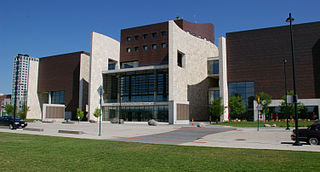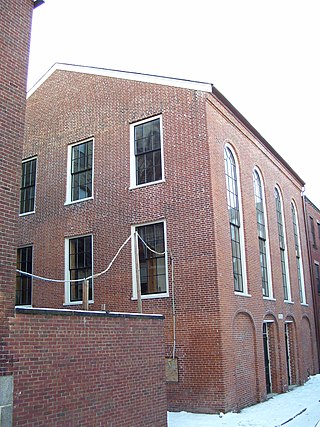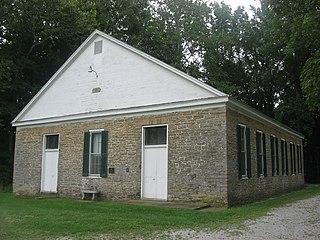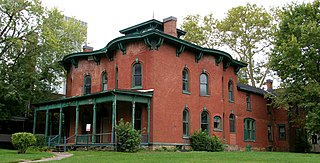
Ripley is a village in Union Township, Brown County, Ohio, United States, along the Ohio River 50 miles southeast of Cincinnati. The population was 1,591 at the 2020 census.

The National Underground Railroad Freedom Center is a museum in downtown Cincinnati, Ohio, based on the history of the Underground Railroad. Opened in 2004, the Center also pays tribute to all efforts to "abolish human enslavement and secure freedom for all people."

Eleutherian College, which was listed on the National Register of Historic Places in 1993 and declared a National Historic Landmark in 1997, was founded as Eleutherian Institute in 1848 by a group of local anti-slavery Baptists at Lancaster in Jefferson County. The institute's name comes from the Greek word eleutheros, meaning "freedom and equality." The school admitted students without regard to ethnicity or gender, including freed and fugitive slaves. Its first classes began offering secondary school instruction on November 27, 1848. The school was renamed Eleutherian College in 1854, when it began offering college-level coursework. It is the second college in the United States west of the Allegheny Mountains and the first in Indiana to provide interracial education. The restored three-story stone chapel and classroom building was constructed between 1853 and 1856 and presently serves as a local history museum.

John P. Parker was an American abolitionist, inventor, iron moulder and industrialist. Parker, who was African American, helped hundreds of slaves to freedom in the Underground Railroad resistance movement based in Ripley, Ohio. He saved and rescued fugitive slaves for nearly fifteen years. He was one of the few black people to patent an invention before 1900. His house in Ripley has been designated a National Historic Landmark and restored.

John Rankin was an American Presbyterian minister, educator and abolitionist. Upon moving to Ripley, Ohio, in 1822, he became known as one of Ohio's first and most active "conductors" on the Underground Railroad. Prominent pre-Civil War abolitionists William Lloyd Garrison, Theodore Weld, Henry Ward Beecher, and Harriet Beecher Stowe were influenced by Rankin's writings and work in the anti-slavery movement.
John Todd was an American Congregationalist minister, co-founder of Tabor College in Tabor, Iowa, a leading abolitionist and a conductor on the Underground Railroad.

Thomas Garrett was an American abolitionist and leader in the Underground Railroad movement before the American Civil War. He helped more than 2,500 African Americans escape slavery.

The Boston African American National Historic Site, in the heart of Boston, Massachusetts's Beacon Hill neighborhood, interprets 15 pre-Civil War structures relating to the history of Boston's 19th-century African-American community, connected by the Black Heritage Trail. These include the 1806 African Meeting House, the oldest standing black church in the United States.
Hortense Parker Gilliam, born Hortense Parker (1859–1938), was the first known African-American graduate of Mount Holyoke Female Seminary, in 1883. She taught music and piano at elementary school in Kansas City, Missouri from 1906 to 1913. That year she married James Marcus Gilliam, and moved with him to St. Louis, where she taught music and lived the rest of her life.

The Coffin House is a National Historic Landmark located in the present-day town of Fountain City in Wayne County, Indiana. The two-story, eight room, brick home was constructed circa 1838–39 in the Federal style. The Coffin home became known as the "Grand Central Station" of the Underground Railroad because of its location where three of the escape routes to the North converged and the number of fleeing slaves who passed through it.

The Owen Lovejoy House is a historic house museum on East Peru Street in Princeton, Illinois. Built in 1838, it was for many years home to Owen Lovejoy (1811-1864), a prominent abolitionist and congressman. Lovejoy, the brother of martyred abolitionist, Elijah Lovejoy, was an open operator of shelter and support on the Underground Railroad, and his house contains a concealed compartment in which escaped slaves could be hidden. It was declared a National Historic Landmark in 1997. It is open seasonally or by appointment for tours.

Wilson Bruce Evans House is a historic house at 33 East Vine Street in Oberlin, Ohio. Completed in 1856, it served a major stop on the Underground Railroad, with its builders, Wilson Bruce Evans and Henry Evans, participating the 1858 Oberlin-Wellington Rescue, a celebrated rescue of a slave. It was declared a National Historic Landmark in 1997.

The Nathan and Mary (Polly) Johnson properties are a National Historic Landmark at 17–19 and 21 Seventh Street in New Bedford, Massachusetts. Originally the building consisted of two structures, one dating to the 1820s and an 1857 house joined with the older one shortly after construction. They have since been restored and now house the New Bedford Historical Society. The two properties are significant for their association with leading members of the abolitionist movement in Massachusetts, and as the only surviving residence in New Bedford of Frederick Douglass. Nathan and Polly Johnson were free African-Americans who are known to have sheltered escaped slaves using the Underground Railroad from 1822 on. Both were also successful in local business; Nathan as a caterer and Polly as a confectioner.

The John P. Parker House is a historic house museum at 300 North Front Street in Ripley, Ohio. It was home to former slave and inventor John P. Parker (1827–1900) from 1853 to his death in 1900. Parker was an abolitionist and a well-documented conductor on the Underground Railroad, helping hundreds of escaped slaves. The house was listed on the National Register of Historic Places in 1980, and it was further designated a National Historic Landmark in 1997. It is now owned and managed by a local nonprofit organization as a museum about Parker's life and the abolitionist movement.

The Mount Pleasant Historic District encompasses the historic center of the village of Mount Pleasant, Ohio. Founded in 1803 by anti-slavery Quakers, the village was an early center of abolitionist activity and a well-known haven for fugitive slaves on the Underground Railroad. The village center is relatively little altered since the antebellum period. The district was listed on the National Register of Historic Districts in 1974, and was designated a National Historic Landmark in 2005.

The Underground Railroad in Indiana was part of a larger, unofficial, and loosely-connected network of groups and individuals who aided and facilitated the escape of runaway slaves from the southern United States. The network in Indiana gradually evolved in the 1830s and 1840s, reached its peak during the 1850s, and continued until slavery was abolished throughout the United States at the end of the American Civil War in 1865. It is not known how many fugitive slaves escaped through Indiana on their journey to Michigan and Canada. An unknown number of Indiana's abolitionists, anti-slavery advocates, and people of color, as well as Quakers and other religious groups illegally operated stations along the network. Some of the network's operatives have been identified, including Levi Coffin, the best-known of Indiana's Underground Railroad leaders. In addition to shelter, network agents provided food, guidance, and, in some cases, transportation to aid the runaways.

Red Oak Presbyterian Church is a historic church on Cemetery Road in Ripley, Ohio.

Cozad–Bates House, also known as the Cozad–Bates House Interpretive Center, is the oldest and only surviving pre-Civil War structure in University Circle, Cleveland, Ohio, located at the Mayfield Road and East 115th Street intersection. It is historically known for its involvement in the Underground Railroad. Abolitionist Andrew Cozad built the house in 1853 for his son Justus L. Cozad, who in 1872 added an Italianate front to the structure. Architecturally, it is a rare surviving example of Italianate-influenced residential architecture in America at that time, which includes a hipped roof, curved bay windows, paired eave brackets, and prominent belvedere. The house was listed on the National Register of Historic Places in 1974 and designated as a Cleveland Landmark in 2006.

Spring Hill is a historic home museum in Massillon, Ohio. The estate was settled and started by Thomas and Charity Rotch, and it was eventually owned by the Wales family for three generations. Spring Hill is recognized on the National Park Service Underground Railroad Network to Freedom. The estate encompasses the main house and several outbuildings, including a smokehouse, spring house, milk house, and wool house


















